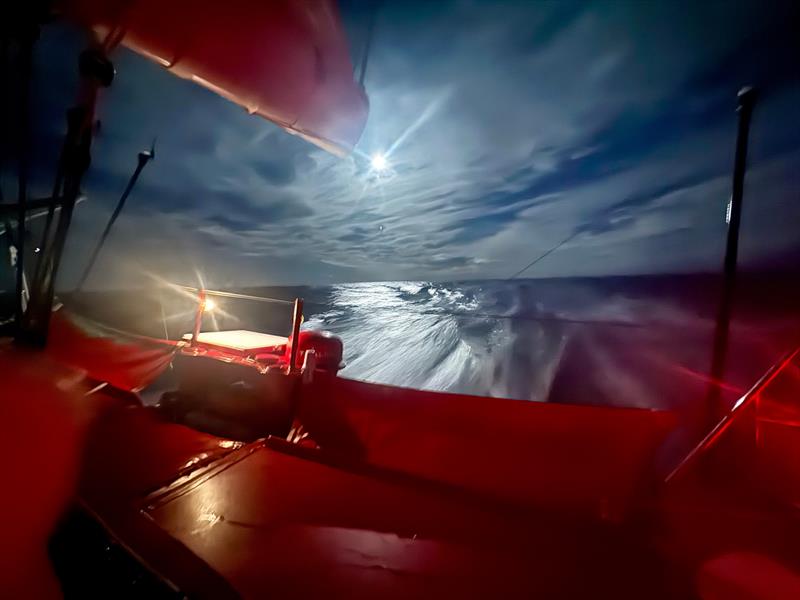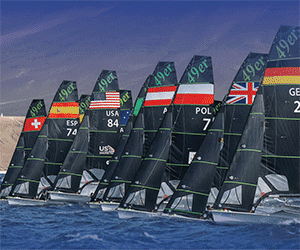
Vendée Globe Race – Day 11 – Lead Shift and New Speed Record
by Richard Gladwell, Sail-World NZ 21 Nov 06:19 PST
21 November 2024

Sam Davies (Initiatives-Coeur) – Vendée Globe – November 17, 2024 © Sam Davies


Sam Goodchild (Vulnerable) has taken over as the new leader of the Vendée Globe Race, surging ahead at 24 knots, as the lead group sails past the Cape Verde Islands towards the Doldrums.
As of the 2200hrs UTC update on November 19, Seb Simon (Groupe Dubreuil) occupies the second position, sailing at 22.5 knots and trailing the new leader by 41 nautical miles.
Race favorite Charlie Dalin is in third, 57 nautical miles behind Goodchild, sailing at a slightly faster speed of 23.5 knots.
New 24-hour solo monohull record for Yoann Richomme
The Vendée Globe Race reports that French solo skipper Yoann Richomme has covered an impressive total of 551.84 nautical miles from yesterday at 9:30 to today (Nov 20) at the same time, equivalent to 1,022 kilometers. Richomme has been sailing fast since yesterday in northeast trade winds over a mostly calm sea.
Richomme’s performance surpassed the previous record set by Nicolas Lunven (Holcim – PRB) on November 12 and 13 by 5.24 miles in this race. The World Speed Sailing Record Council is yet to confirm this distance record.
The competition is tightening, with 100 nautical miles separating the top eight boats on the water. Sam Davies (Initiatives-Coeur) currently holds the eighth position within this competitive group, all of whom are sailing foiling boats.
Former race leader Jean Le Cam is now in 15th place, clocking a speed of 16.3 knots during the 2200hrs update on November 19. He seems to still be in the wind shadow of the Cape Verde Islands, particularly influenced by Mt. Fogo (9,281ft), the tallest peak in the group. The 65-year-old veteran was leading the race until earlier on November 19. Alongside Conrad Colman (MS Amlin), Le Cam was one of the only two to navigate between the Cape Verde Islands and the West African coast amid the strong influence of the Sahara desert.
Their strategy, although promising at times, contradicted the traditional round-the-world racing strategy of “West is Best.”
The fleet has often divided into three groups—west, central, and east—but they have now converged, yet Le Cam still finds himself 400 nautical miles east of Goodchild.
With the exception of Conrad Colman, the remaining fleet is heading south in search of a swift passage through the Doldrums, which appear significant but still offer some pathways. The 39 boats in the Vendée Globe Race will be making intermittent jumps through the area, continuously updating their routes with every weather data update.
Routing is based on the 1000 UTC position update and the 0800 UTC Predictwind weather report.
It seems that, based on the available data, race leader Sam Goodchild is experiencing, or has experienced, a favorable passage through the Doldrums, hardly slowing down. A similar opportunity appears to be in store for his teammate in TS Racing, Thomas Royant.
The notorious calm stretch that could have taken several days to cross has fortuitously closed up, allowing both yachts, and likely most of their nearby competitors, a similar fast passage. (In Predictwind’s summaries, wind data is reported in six-hour intervals, meaning a virtual boat in the Doldrums may not show as such unless the duration exceeds six hours.)
According to the Predictwind routing, they are anticipated to reach the Southern Ocean and approach Cape Horn in approximately 9.5 days.
However, their journey toward the Ice Gate may not be as smooth as their traverse through the Doldrums, given the extensive areas of light winds that are developing in the region typically dominated by the South Atlantic or the St. Helena High.
There are also patches of strong winds moving through the same area, and there will be many opportunities for the race to be won or lost over the remaining 19,000 nautical miles.
The image above clearly shows large windless regions (blue and purple) that are significantly larger than the actual Doldrums. The area continues to experience strong frontal systems.
For an explanation of the various weather feeds employed by Predictwind, click here.


